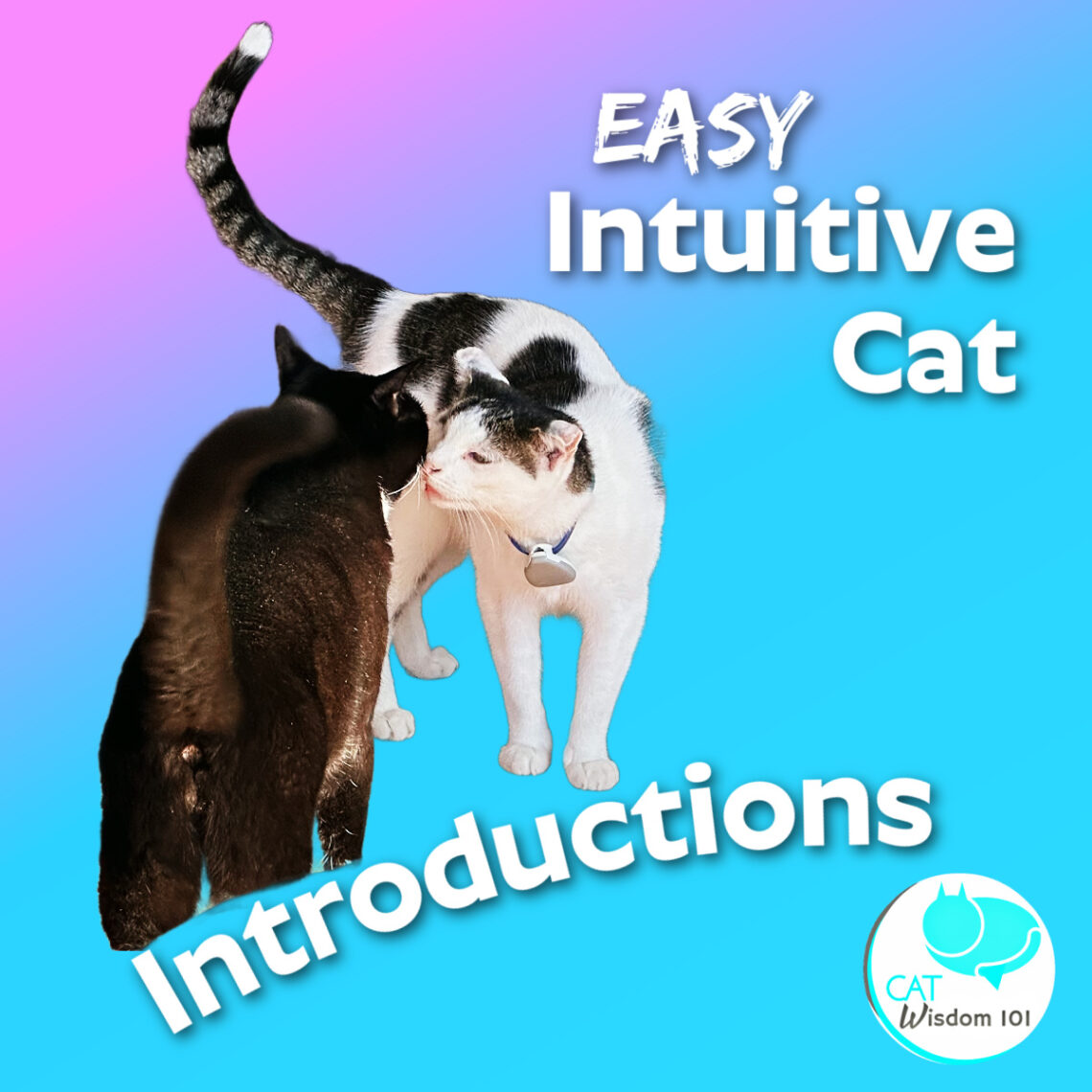
New Cat Introductions: Intuitive and Practical Guide
Introducing a new feline friend to your existing cat is a delicate dance of understanding their energies and instincts. Follow our new cat’s adoption journey to meeting resident cat, Odin with practical and intuitive step-by step tips.
If you missed part 1 of Otto’s adoption journey during Adopt-a-Senior Pet Month. Yes, that’s Otto helping supervise wrapping Christmas gifts!

The journey continues with how the intuitive approach to make a shelter cat feel at home and introduce them to other pets.
- In less than a week, Otto has adjusted fully to his new home.
- Happily explored every nook and cranny without hiding.
- Exhibiting all healthy behavior: eating, drinking, peeing, pooing, grooming.
- Sleeping and interacting with myself and my husband, showing affection, playfulness and curiosity.
- Meeting resident cat Odin and friendly interactions.
This is how I did it.
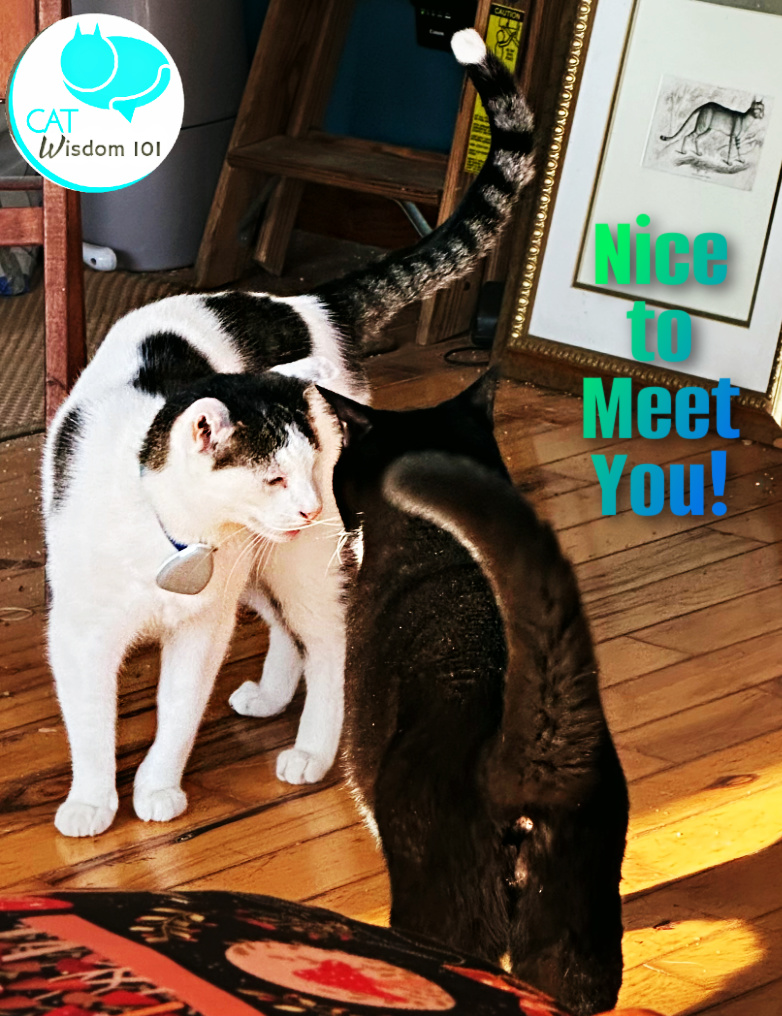
The stand out lesson from the past few days is: expect the unexpected and adjust. Assume nothing. Observe. Stay calm.
Whether this is your first cat or your 10th, every cat is different. What might have worked with a previous cat, may or may not work this time. It all comes down to the personality of the two or more cats. I knew Otto was a confident, headstrong cat and Odin, a confident and more passive cat. He has never displayed aggression in 13 years. Their characters are very similar or simpatico and I think that helped.
Gender differences matter. In my experience, female cats tend to rule the roost. It’s easier to introduce a kitten to an adult cat but there are exceptions to every rule. Not everyone can make positive introductions as quickly as I did but it is possible. It’s not unusual to take a few weeks and that’s okay too.
Using your intuition and observation skills will make a huge difference.
If possible, take a few days off after bringing kitty home to spend time observing and communicating. Discrete photography is useful to observe behavior (no flash or anything invasive). Through your intuitive connection, notice signs of curiosity, calmness, or tension in their energies. When the time feels right, introduce them in a neutral area, allowing them to approach each other at their own pace. Your intuition will guide you to sense when they’re ready for closer interactions.
Cats are intuitive and mysterious beings which is why cat lovers adore them. I think there is a reason why certain cats show up in our lives, for better or worse. Otto is already slipping into his role as a creative muse but your new cat has their own unique purpose.

Here are some ways to enhance your intuition to enhance your connection with your cat and understand them better:
- Meditate with or without your cat. Meditation is a powerful way to calm your mind and tune in to your intuition. By meditating with your cat, you can create a peaceful and harmonious energy that allows you to communicate with them on a deeper level. You can simply sit or lie down with your pet and focus on your breathing, or you can use a guided meditation that helps you visualize your pet and send them love and gratitude. Being relaxed is the quickest way for your cat to chill since cats easily pick up on our emotions and can mirror them.
- Play music to calm your cat using isochronic tones or binaural beats. I like 528hz. There are many cat-only calming music on YouTube I played it Otto as soon as we got home. Within a few minutes, he was purring on my lap in bed.
- Ask your pet questions BUT only when you are feeling calm and centered. One of the simplest ways to communicate with your pet is to ask them questions and listen for their answers. You can do this out loud or in your mind, depending on your preference. You can ask them about their likes, dislikes, feelings, needs, or anything else you want to know. The key is to be open and receptive to their responses, which may come in the form of words, images, sensations, emotions, or impressions. EVERYONE is intuitive. Trust the process. Don’t second guess and it’s a skill that improves with time and effort.
- Pay attention to your cat’s body language. As I mentioned before, your cat’s body language can reveal a lot about their mood and personality. However, you can also use your cat’s body language as a way of communicating with them. For example, you can mimic their movements, gestures, or expressions to show them that you understand and respect them. You can also use your own body language to convey your messages to them, such as smiling, nodding, or pointing.
- Consult a professional animal communicator. If you want to get more detailed and accurate information from your pet, you may want to consult a professional pet psychic or animal communicator. They can tune in telepathically and relay messages between you and your pet. They can also help you with finding lost animals, resolving behavioral issues, or connecting with a passed-on pet.
- I have a few more tools of a woo woo nature which I’ll explore in another article. See also my Intuitive Cat Communication 101
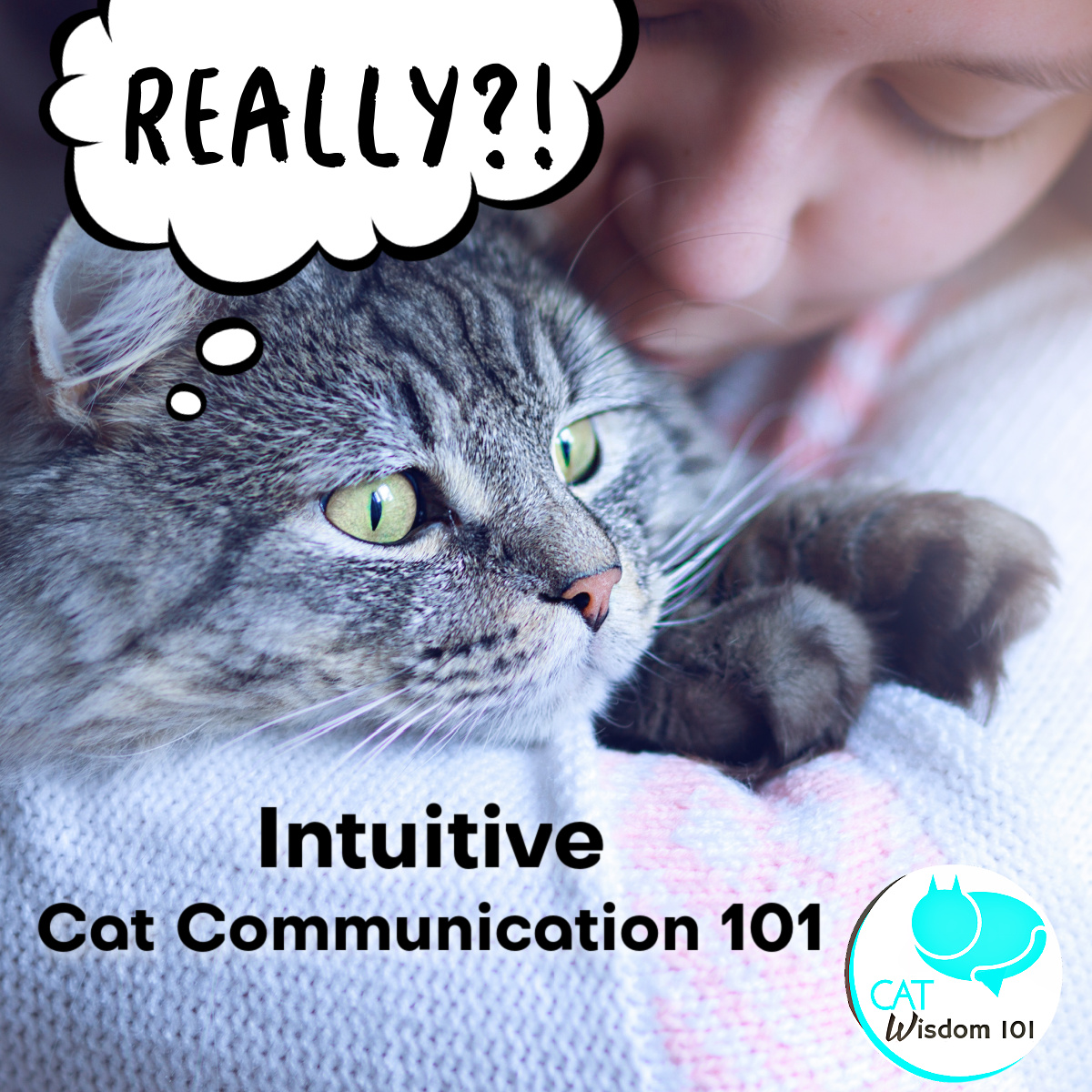
Here are basic cat language tips to understand your cat better:
- Body posture and tail. Perhaps the most telling part of cat body language is overall body posture, including tail behavior. A confident cat will stand tall and straight, while a fearful cat will crouch low and curl up. A relaxed cat will lie on their side or back, exposing their belly. A playful cat will arch their back and raise their tail, while an angry cat will puff up their fur and tail. A happy cat will curl their tail around you or another cat, while an annoyed cat will flick their tail back and forth.
- Eye contact and ears. Eye contact is a common communication technique between cats. A direct stare is a sign of challenge or aggression, while a slow blink is a sign of affection or trust. A relaxed cat will have their eyes half-closed, while a scared cat will have their eyes wide open. Ears are also a good indicator of mood and attention. A relaxed cat will have their ears pointed slightly forward, while an alert cat will have their ears upright and facing forward. A fearful or submissive cat will have their ears flattened to the side or back, while an angry or aggressive cat will have their ears pointing backward and downward.
- Physical contact. Physical contact is also an important part of cat body language. Cats use physical contact to show affection, dominance, or submission. A cat who rubs their head, cheek, or body against you or another cat is marking you with their scent and expressing their bond. A cat who licks you or another cat is grooming you and showing their care. A cat who bites you or another cat gently is playing or teasing, while a cat who bites you or another cat hard is warning or attacking. A cat who rolls over and exposes their belly is inviting you to play or showing their trust, while a cat who scratches you or another cat is defending themselves or asserting their territory.
- Vocalization. Cats use a variety of sounds to communicate their feelings and needs. A meow is a general sound that can mean different things depending on the tone and context. A high-pitched meow can indicate excitement, happiness, or hunger, while a low-pitched meow can indicate annoyance, anger, or pain. A purr is usually a sign of contentment, but it can also be a way of soothing themselves or asking for attention. A growl, hiss, or spit is a sign of aggression, fear, or warning, while a yowl or howl is a sign of distress, loneliness, or mating.
- Chemical signals . Cats also use chemical signals to communicate with each other and mark their territory. These signals are invisible to humans, but they can be detected by other cats through their sense of smell. Cats have scent glands on their face, paws, and tail, and they use them to rub their scent on objects, people, or other cats. This is a way of claiming ownership, showing affiliation, or leaving a message. Cats also use urine or feces to mark their territory, especially if they feel threatened or insecure.
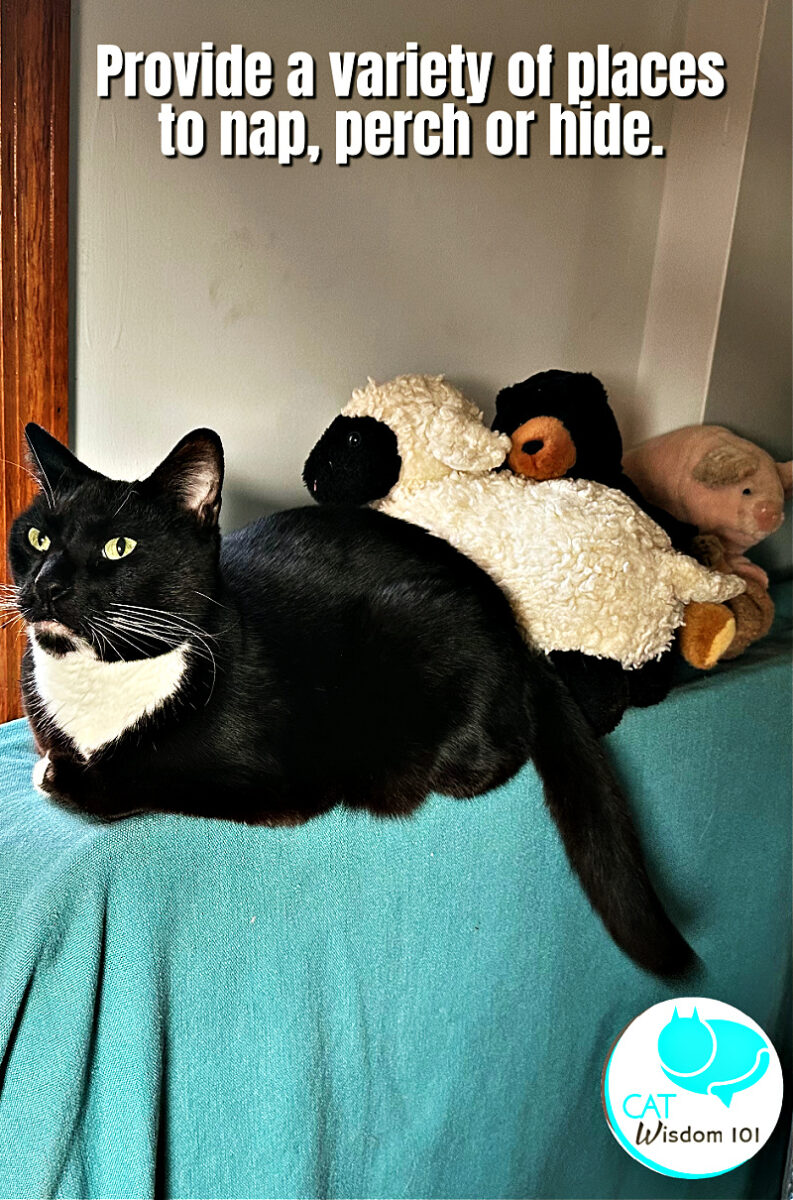
- Prepare your home: Whether it’s a small studio or a big multi-story house, the considerations are the same. Before bringing your new cat home, make sure you have a separate room or area for them to stay in. This will help them adjust to their new surroundings and feel safe. Ensure that the room has all the necessary supplies, such as food, water, litter box, and toys. You can also add some items that smell like you or the resident cat, such as a blanket, a pillow, or a toy. This will help them feel more comfortable and familiar with their new environment
- Provide separate resources: Make sure each cat has their own food, water, and litter box. This will help prevent any territorial disputes or competition for resources.
- Food Considerations: If you know what the shelter was feeding, try that food before gradually transitioning to a new food. In Otto’s case it was Fancy Feast wet and dry. I’ve opposed feeding dry food for many years, but for now Otto is getting some dry. It’s normal for a new cat to go off their food for a few days. I fed some Churu and Delectibles as a treat to kick start his appetite. After face-to-face introductions decide on where communal feeding can occur to facilitate bonding. Cats can share a water fountain but please provide separate food bowls placed a few feet apart. We also have a feeding station for Odin upstairs and Otto still has his in his safe room for now.
- Be patient: Introducing cats to each other can take time. Be patient and don’t rush the process. If you encounter any problems, seek advice from a veterinarian, animal communicator or cat behaviorist.
- Another vet check: Most shelter cats are vet checked, spay/neutered, vaccinated and micro-chipped. After your cat has settled in, I would suggest another vet check with your vet to gain more data about their health. A senior panel as a baseline is especially useful for an older cat. If your other cat or pets go outdoors, a decision will have to be made about flea/tick protection.
If there are other family members, be sure everyone knows about the introduction plan, agrees to it and sticks to it.
Reward good behavior: When the cats interact positively, reward them with treats or praise. This will help reinforce good behavior and encourage them to get along. You can also use positive reinforcement techniques such as clicker training or operant conditioning to teach them specific behaviors that you want to see more of. Otto is very food motivated and training has begun i.e. staying off kitchen counters.
Otto explored one large room with four windows but he ignored the cozy basket and armchair which Odin loves. Never assume any preferences. For a few days he slept at the foot of the bed but loves my silk pillow cases now. I didn’t expect him to make biscuits and damage it but c’est la vie. If you haven’t already cat-proofed or removed off limit items, please do.

- Introduce the cats’ scents: Rub a damp washcloth or sock on the new cat, then rub it on the resident cat, and let each cat sniff it. This will help them get used to each other’s scent. You can also exchange their pet beds or blankets with each other. This will help them associate each other’s smell with positive things. After they have met, notice how one cat, let’s say jumps onto a favorite chair, will the other cats sniff it after they leave.
Supervise the first few interactions: When you first introduce the cats, make sure to supervise them closely. Keep them in separate rooms and let them sniff each other through a crack in the door or a screen. Gradually increase their interaction time and monitor their behavior. You can use an intuitive animal communicator or cat behaviorist to help you interpret their body language and vocalizations. How depends on the cats. It’s could be days or weeks. DON’T RUSH!
- Offer reassurance and positive reinforcement through gentle strokes or soft words, fostering a sense of security for both cats. Keep a watchful eye on their interactions, intervening calmly if tensions arise, and offering space if needed. and redirection.
I created a barrier with a window screen gate which has worked well. I like it better than a baby gate which Odin could easily jump over. On the second day, we opened it and Otto was keen to explore the rest of the second floor. We kept the door to the first floor closed. Because Odin goes outdoors daily, we have a new system of keeping doors open or closed until there is a full integration.

We are keeping the gate up but open for the time being.
Remember, expect the unexpected! We thought the safest time for Otto to explore downstairs would be when Odin was outdoors. We did not expect a visual meeting but Odin appeared at the patio door at the same time as Otto. Odin placed his paw against the glass in friendly gesture. Both cats appeared relaxed and my husband opened the door. They sniffed and kissed with no drama. Odin walked away nonchalant.
Since then, they have had supervised meetings in different rooms of the house. Progress was smooth so we kept the separation gate open a night a couple nights ago with no issues EXCEPT Otto preferred sleeping in another room and not with me. The dynamics as we all adjust will keep changing. Odin ignored me for five days but back to his old self. We are conscious about giving Odin more attention and treats. Otto is an equal opportunity kitty, spending time and showing affection to both my husband and myself. As I write this in bed, Otto is sleeping on my silk pillowcase.
The invisible scent network
- Ever home has one. Odin and Otto have an elaborate scent network. Every spot occupied and vacated is sniffed and occupied by the other. Placing catnip on a scratching Bergan toy (Amazon sale link) was a huge bonding place. Both cats visit multiple times a day to scratch, sniff, leave their scent and bond. Fortunately Otto does respond to catnip (30% of cats don’t).
If you have a partner or kids, get them in involved to track progress. My husband sent me this today from his office.

Every day, new cats will explore in their own time and rhythm to find their favorite spots. There will likely be spots cats share or timeshare on schedules we know nothing of. Some spots will remain theirs alone like Odin’s aerie on top of an armoire.
When you trust your intuition, there can be wonderful surprises. There is always a lovely, late afternoon light, but I’ve never seen anything like this. Otto was following Odin around. They kissed and a bright prism of light bathed both of them. Photos of all our OTRB cats have popped up in our computers lately. I’d like to think they are sending their approval and welcoming Otto from the Rainbow Bridge. Wacky? Maybe. What do you make of this?

I had to do a double take when I saw Otto and hubby on the old leather lounger by the fire where Odin usually sits, as did Domino, Clyde, Gris Gris, Nou Nou and Merlin.
Remember, your intuition coupled with understanding feline body language will guide you through this process as it did with mine.
Patience, love, and respect for their individual energies will pave the way for a harmonious bond between your shelter cat and existing feline companion. Good luck!
If you have a tip that worked well for you, let me know in a comment.

P.S. I hope you enjoyed this New Cat Introductions post. Keep in mind, Otto arrived barely a week ago and there are many changes ahead as we all acclimate. I’ll do my best to keep observing and reporting on his progress.
xo, Layla, Odin and Otto




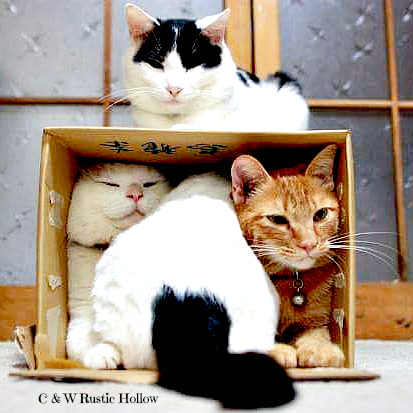
11 Comments
Briar
It is so great to see this “good news story.”
Cat and Dog Chat With Caren
I am hoping you submit this series to the CWA because you definitely deserve to win, you should submit your Thanksgiving post as well! I LOVE these tips. When I introduced both of my cats and dogs to each other I NEVER went by what the “experts” said to do…….never separated them……..I relied on my instincts and close supervision as well. I also made it quite clear that “you are both going to get along dammit” lmao! Love you!
Layla Morgan Wilde
Caren,thanks so much! I’ll consider submitting it xoxo
meowmeowmans
Aww, I’m so happy the Otto is acclimating so well into his new forever home! Love that he and Odin are getting alog so well already. 🙂
easy rider
we hope this wish will be granted…
Brian's Home Blog
That is so wonderful that all is calm and all went smoothly!
Layla Morgan Wilde
Smooth but they are both super active 🙂
Meezer'sMews&TerrieristicalWoofs
Wow, Otto is quite easy going…and he knows he’s loved to the max already, maybe even by Odin!
Otto seems to be implying Yes, Yes, YES!
Layla Morgan Wilde
Yup, it won’t be long now. They are similar in temperament which really helpred.
Amy Harlib
Wonderful detailed information. So glad the integration process for Odin and Otto is working out so well!
Lovely rainbow photo is a good omen for sure!
Purrs!
Layla Wilde
Thanks, Amy! Agreed about the Rainbow omen. It’s funny, I was waiting for it to happy again on a sunny day but it didn’t.